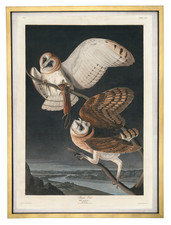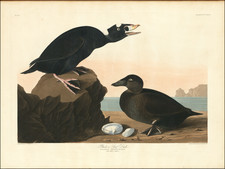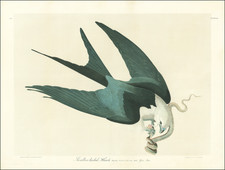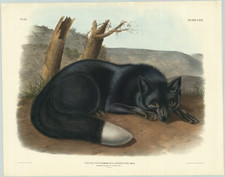A fascinating late-18th-century watercolor drawing of a series of Indian and Southeast Asia arthropods and lizards, attributed to Johannes Schumacher or another associate of William Paterson, the famous explorer, natural history collector, and eventual Lieutenant Governor of New South Wales.
The drawing features a scorpion (seemingly a member of the genus Chersonesometrus, native to Mysore, India), a tropical carpenter bee (possibly Xylocopa latipes), a member of the order Solifugae (often called sun spiders or camel spiders), along with a study of a head of the same, an unidentified stink beetle, an unidentified but probably Indian snake, two unidentified geckos, an unidentified lizard, and an unidentified praying mantis. While many of these animals are difficult for us to identify, the circumstantial evidence points to there having been gathered and documented in Mysore in the 1780s.
This drawing belongs to a group of nine newly discovered watercolors from the end of the 18th century, all of which show animals native to the regions bordering the Indian Ocean. These drawings are closely associated with a series of natural history watercolors in the Brenthurst Library, South Africa, which is widely referred to as the Paterson Album(s). It is believed that the Album was compiled by William Paterson (1755-1810), an important figure in the natural history of southern Africa and the early colonial history of Australia. Several of the drawings in the present group are identical or nearly so to images found in the Paterson Album.
The presence of the initials "J.S." on two of our drawings (albeit effaced on one of them) strongly suggests that these drawings were authored by Johannes Schumacher, a German (or Dutch?) artist previously contemplated in the literature as a potential contributor to the Paterson Album. Schumacher is known to have made drawings in Africa for both Hendrik Swellengrebel Jr. (1734-1803) and Colonel Robert Jacob Gordon (1743-1795), and it is through the latter that the artist came into contact with Paterson. The most authoritative and detailed treatment of this subject is L.C. Rookmaaker's 1989 monograph The Zoological Exploration of Southern Africa, 1650-1790, which summarizes and critiques the conclusions of Vernon S. Forbes and John Rourke's 1980 Paterson's Cape Travels, 1777 to 1779. Many of the drawings from the Paterson Album are reproduced in those two books and in Mike Nicol's 1983 Africana Animals. There is much worthy information in Rookmaaker, but for the purposes of attribution, the most significant passage is on page 168:
Identical drawings in Gordon Atlas. In [Paterson] Album 1 there are 14 drawings with (near-)identical counterparts in the Gordon Atlas. Twelve of these are enumerated by Forbes & Rourke (1980:55), to which should be added f.18 (=GA 197) and f.31 (=GA 221). Among the plants there are 9 occurring both in the Paterson Albums and the Gordon Atlas (Forbes & Rourke 1980:178), Gordon's artist was Johannes Schumacher (see 7.6). Still, Forbes & Rourke (1980:53) conclude that 'Schumacher made no contribution to the three Paterson Albums.' They base this on the assumption that Gordon employed two artists, Schumacher for the scenery and another for natural history. I cannot subscribe to this view (7.6) and, on the little available evidence, I would attribute the identical drawings to Gordon and Schumacher (as did Gunn & Codd 1981:274).
The Gordon Atlas to which Rookmaaker refers is now held in the Rijksmuseum. It is a voluminous and diverse collection that was primarily prepared during the 1770s expedition(s) on which Paterson and Schumacher accompanied Gordon into the African interior.
These drawings were produced during a great expansion of Britain's empire in Africa, India, and Australia and a concurrent flourishing of natural history illustration. Several of the drawings in this group recall Indian Company School drawings by the Impey Circle of Ram Das, Bhawani Das, and Zayn al-Din. In particular, the flying fox is redolent of the now-famous drawing of an Indian fruit bat by Bhawani Das, which last sold at Sotheby's in 2021 for over £640,000. The drawings of the chameleon and the loris make use of a botanical backdrop with leaves flattened to show their faces to the viewer. Zayn al-Din particularly favored this same convention.
A Further Clue: Paterson in India
The possibility that Paterson was aware of the Impey drawings and that some of the present drawings were made for him in India, tantalizing as it is, is not idle speculation. One of the drawings in the present set, of a green snake, sports an inscription ending: "[J.S.] Syringham [1785, or possibly 1783]". Unfortunately, the initials and date have been partially erased but are still somewhat legible. Critically, Paterson was in India between 1781 and 1785, fighting in the Second Anglo-Mysore War, and Srirangapatna, at the time Seringapatam, was the capital of Mysore. Was that drawing made for Paterson in India? Rookmaaker again helps clear this up (pages 168-69):
Paterson later made a collection of drawings in India, which can be here discussed briefly because it may shed some light on him as an artist. He made some remarks about these drawings in his letters to William Forsyth. On 20 June 1783, he wrote from Trichinopoly that the fighting had prevented him from collecting plants or seeds, while he had 'been able to make about 100 drawings many of which I am certain are not in the Hortus Malabaricus.' He was quite happy with those drawings, as on 21 December 1783 he wrote from Coimbatore 'that I have succeeded very well indeed & I flatter myself if no accident happens that they will astonish you when you see them. When he was waiting to return home, he wrote on 23 December 1783 from Porto Nova:
and I may venture to say that should I have the good fortune of getting everything safe home, that such a collection was never yet brought into England, particularly the Gentoo architecture and some of the most famous buildings in India, also these of different gods & godesses, both in drawing & in copper with some part of their history, and also a description of the world by the Bremmins [= Brahmins] and also a tolerable collection of drawings of plants, birds, &c.
Considering these passages, one may conjecture that this Indian collection contained several hundreds of sketches representing buildings as well as animals and plants. Paterson stated to have 'made' the drawings, which of course, would establish him as an active and important artist. It must be agreed, however, that the evidence is very slight. Paterson could have meant that he made the drawings by acquiring or commissioning them. Paterson showed his collection in London, as appears from two sources. In an undated letter to Thomas Pennant (1726-1798) in the library at Vergelegen, Somerset West (reproduced by Forbes & Rourke 1980:24, 26) Paterson wrote: 'I was last night with the Royal & Antiquies Society showing my drawings of the Indian buildings.' John Latham in his General Synopsis of Birds (Supplement, 1787:124, 125, 147) recorded three Indian species, the Blue and the Red-billed Promerops and the Indian coly, of which a representation was found 'among the drawings of Captain Paterson.' The description of the 'Red-billed Promerops' was the basis of Latham's (1790,1:280) Upupa indica. The subsequent fate of Paterson's Indian drawings is not known. They were not included among the drawings used by Latham discussed by Sawyer (1949). It is important to realise, however, that the Paterson Albums contain drawings of 85 plants and 12 animals unknown from South Africa. Some of these might once have been part of the Indian collection.
From the available evidence, it must be concluded, as did Forbes & Rourke (1980:55), that Paterson 'drew few if any' of the drawings in the Paterson Albums. Muir (1933a) on the other hand commented upon Paterson's considerable talent and great skill as draughtsman, but his statement may only have taken into account the existence of the Paterson Albums. If Paterson assembled the drawings during his visits to South Africa and India, there is no need to look for a single responsible artist. Their origins may be quite mixed, which is also the case with many other contemporary collections of drawings. I am unable to identify the artists on the basis of styles alone. It is, therefore, only possible to look at the little evidence available from other considerations.
Paterson's stay in India overlapped with that of Chief Justice and Lady Impey, who were there from 1777 to 1783. We may never know what, if any, influence their drawings had on the course of Paterson's natural history art collecting. Still, it is clear enough that such pursuits were widespread among the British in India at this time.
Aside from possible Indian influences, the composite image of reptiles and invertebrates in this group cannot help but recall Jan van Kessel the Elder and his circle of 17th-century Continental natural history artists. Elsewhere, the drawings bring to mind Aert Schouman, though any similarity may be coincidental.
The present drawings are on partial sheets of laid paper of Whatman manufacture with watermarks of the Fleur de Lys, on an ornamented shield, with the pendant letters GR and countermarks J WHATMAN, without a date. The mill used this combination of watermark and countermark from 1775 to 1794, after which they began adding dates below the countermark.
It should be noted that while we believe the initials indicate Schumacher's involvement, the inscriptions themselves are very unlikely to be his; according to Rookmaaker, Schumacher wrote in a German-Dutch mixture in keeping with his background, whereas the present hand is distinctly late-18th-century British. Furthermore, a comparison of the inscriptions with some of Paterson's known manuscripts leads us to believe that he was probably not the author of the labels on these drawings.
Conclusion
The present drawing belongs to a group of 9 related drawings, many of which are identical to drawings in the famous Paterson Albums at Brenthurst Library in South Africa. These drawings were likely made in India and Africa between the late 1770s and mid-1780s. Based on the inclusion of the initials "J.S." on two of the drawings, we propose that they were authored by Johannes Schumacher, an artist previously proposed as a contributor to the Paterson Albums. Additionally, we raise the possibility that these drawings were influenced by the so-called Company School works made by Indian artists for British colonials during this period.












![[ The First Zoological Map / 3 Volume Pioneering Work on Biogeography ] Tabula Mundi Geographico Zoologica sistens Quadrupedes hucusque notos sedibus suis adscriptos editit E. A. W. Zimmerman . . . [with] Geographische Geschichte des Menschen, und der allgemein verbreiterten vierfüßigen Thiere, nebst einer hieher gehörigen Zoologischen Weltcharte, von E.A.W. Zimmermann, Professor am Kollegio Carolino zu Braunschweig.](https://storage.googleapis.com/raremaps/img/small/104951.jpg)



![The Chameleon. full size._ [Original watercolor of an Indian chameleon.]](https://storage.googleapis.com/raremaps/img/small/103915.jpg)